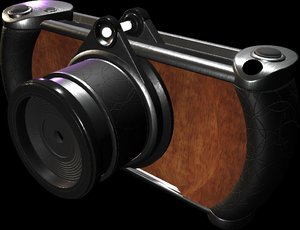
The Camera is the default available camera a user can bring out (either from a link, file import, or from the Resonate Essentials folder).
This camera comes in two flavors, a regular photo camera and a stream camera. The camera itself visually does not have any difference between the two. The difference comes from the added functionality by streaming from this camera. More details on this section describing the Streaming Camera.
Camera
The camera has a set of features and functions.
Top of the camera
- The top button on the right takes the picture immediately. Pictures will spawn and stack below the camera after each picture taken.
- The top button on the left shows the preview of what the camera sees. Great for group photos.
Back of the Camera
Behind the camera is a large preview window, showing you what is going to be taken by this camera, along with a set of options on the left, a zoom slider on the right, and information on the bottom. Here is what each thing does:
- Camera Mode Menu: There is 4 modes for the camera. Normal Mode, Stereoscopic Mode, 360 Mode, Focus Mode.
- Normal Mode takes normal pictures.
- Stereoscopic Mode takes pictures that creates a 3D effect. This is essentially 2 images, taken at slightly different angles, to create this illusion. The effect cannot be seen in Desktop Mode and only shows a regular image.
- 360 Mode takes a panoramic image. This is useful for making skyboxes.
- Focus Mode makes the camera shoot a laser, anything in front of that laser will be the focused object for the picture. This also makes the image have a transparent background.
- Reolusion: This controls the resolution or quality of the image once taken by the camera.
- Filter: Shows a menu of a selection of filters you can use for the pictures.
- No Filter: Turns the filter mode off.
- (F1) HDR: This filter adds in more contrast to the image and color, making it have that HDR effect.
- (F2) Grayscale: The image is monochrome black & White.
- (F3) Sepia: The image is monochrome golden yellow, giving the effect of an old-time photo.
- (F4) Invert: The image is inverted with a spectrum of colors.
- Direction: This provides a menu to adjust the cameras view direction. The arrows are presents to view rotations of this camera (great for landscape or portrait mode), and the automatic and manual buttons are for further adjustments.
- Grid: This shows a menu with buttons that toggles the grid, allowing the photographer to use the composition and rule-of-thirds for the picture taking.
- Settings: Shows a menu for other settings for the camera, such as a timer, showing the frustum, toggling a light, and showing the group photo preview. There are other settings here under the described settings.
- Information footer: shows the information to the user of what settings and values this camera is showing.
- Zoom Slider: A slider that controls the camera zoom (or the "Focal Length") for the image. The default starts at
60.
Front of the camera
- There is a zoom ring for the camera (called a "Focal Length Ring"), that zooms in or out when grabbed and used. This also adjusts the slider on the back of the camera.